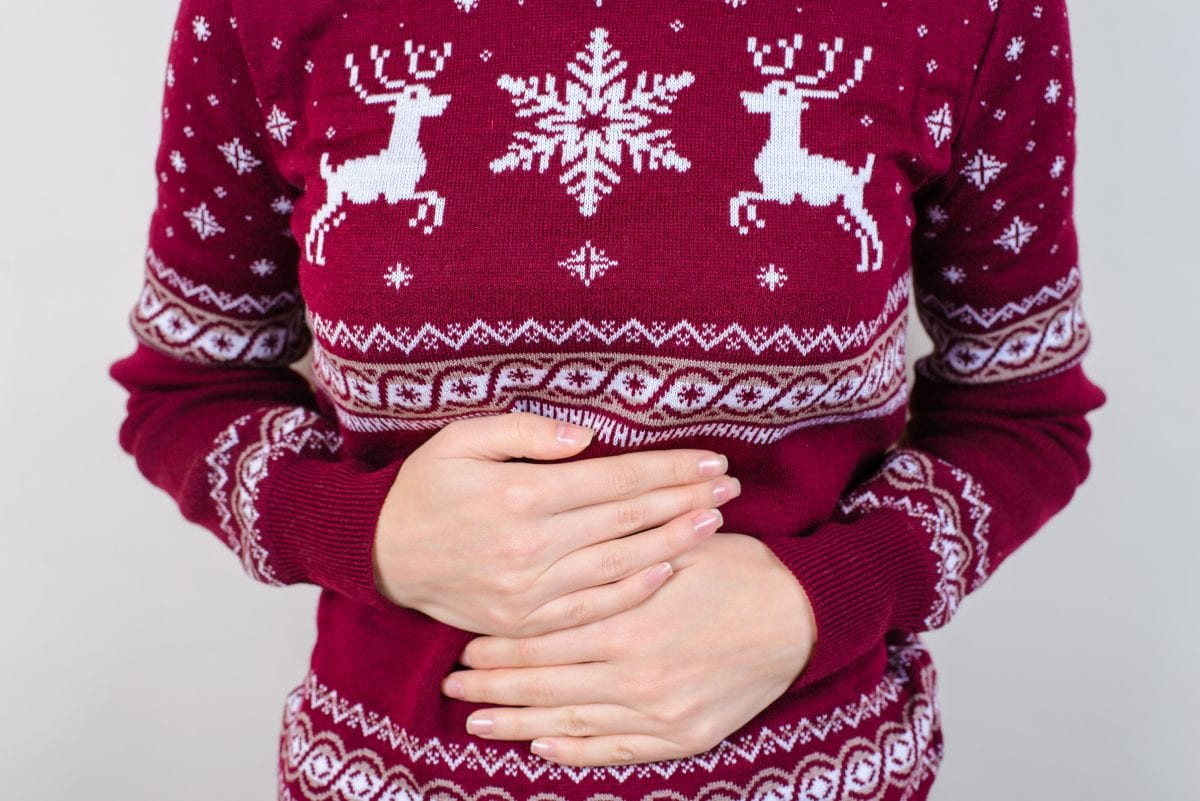Last Updated on February 16, 2025
It’s that time of year again. That’s right – the holidays are back! How did they creep up so fast? I’m not sure either. Do you know what else is back? All of our favorite holiday traditions, including the famous holiday dishes that come with the festivities! These can include special entrees, pies, spiked Egg Nog, and my personal favorite, mom’s famous Oreo ice cream dessert. It just gets better with every serving.
While many of us are hunkering down inside underneath a warm, comfortable blanket next to the bustling fireplace, all of this comfort might still give way to a gnawing question: how do we avoid holiday weight gain this season?

Some Background on Holiday Weight Gain
As wonderful as this time of year is, hunkering down and enjoying our favorite holiday eats comes with a price. All too easily, many of us will pack on some extra pounds. But interestingly enough, most people overestimate the amount of weight they actually put on during this time of year. For example, one study measured weight gain during the fall, winter, and spring months. As I’m sure you could have guessed, they found that the most weight gain occurred during the 6-week winter holiday period (November – January) (1).
However, the average holiday weight gain between the subjects was far less than expected. On average, the subjects gained just .82 pounds from November to January with an additional .4 pounds increase coming from September to November. In contrast, .07 pounds were lost from January to March. This makes for an average of 1.2 pounds of weight gain during the latter part of the year.

Although that may not seem like much, the net weight gained per year was 1.4 pounds. This means that 86% of the weight gain occurred just before and during the holiday season. Even more intriguing, there was a small percentage of the subjects who experienced what the study referred to as “major weight gain”. They equated this term as anyone who gained a minimum of 5 pounds from November – January.
Finally, the study showed that the population of people who fit into the “major weight gain” category during the holiday season were significantly more likely to have already been overweight or obese (1).
The Science Behind Weight Gain and Loss
Now we ask the question: how much weight can you gain in one day? That really depends on how much sodium, carbohydrates and water you consume. The reason is that water weight comes on much quicker than fat weight. This is important to know because both sodium and carbohydrates are hydrophilic, meaning they attract water. You see, carbohydrates break down into glucose that gets stored as glycogen in the muscle, liver and/or fat cells.
That’s important to note because for every one gram of glycogen we store three to four grams of water (2). In a practical scenario, if you indulged in 400 grams of holiday season carbohydrates, you add on 1,200-1,600 grams of water, which could ultimately amount to about three or four pounds of added weight (after metabolization). Sodium has a similar effect on water storage (3).

Most holiday meals contain a high amount of one or both. This induces common symptoms like bloating, which is usually the result of excessive water retention. That could be one of the reasons why carbohydrates are so demonized nowadays. Regardless, it’s fundamental to understanding the mechanisms behind this rapid weight gain.
It’s important to note that one pound of fat is made up of 3,500 calories. This means that in order for a person to actually put on a pound of fat, it would require a 3,500-calorie surplus from your daily calorie needs. Therefore, if we step on the scale one day after Thanksgiving, we may notice the number on the scale has increased a few pounds.
However, we also know that only a fraction of the weight gain is directly equal to the fat weight. The good news is that water weight can come on quickly but inversely can also come off quickly as well. That’s why you will see athletes who have a certain weight to meet for an event often utilize saunas. This is a quick way to reach a specific body weight. The majority of the weight that they end up losing comes from the fluid.
The Roles of Calories and Metabolism
Our daily calorie needs are dictated by what is known as the body’s Basal Metabolic Rate (BMR). This is the number of calories your body needs per day to maintain its current weight. Some of the main factors that dictate your Basal Metabolic Rate are genetics, daily activity (calorie expenditure), gender, age, and lean body mass.
Out of all these factors, you can really control your calorie expenditure and lean body mass. These factors especially cause the rate of calorie expenditure to vary significantly. That’s why former athletes who have been retired for years can still maintain low body fat percentages, as they have built large amounts of lean body mass over time.

Most of us simply want to control our weight and maintain the results that we’ve achieved throughout the year. With that in mind, it’s important to stay just as active (if not more active) during this time of the year when temptations like calorie-rich sweets surround us. By doing so, we can maintain a net calorie intake that is closer to our Basal Metabolic Rate, which is essential in fighting off holiday weight gain.
Smart and Easy Choices for Holiday Exercises
Timing Your Exercises Around Your Meal

Timing your exercise/high-level activities around your meal (especially following your meal) can be very advantageous. Actually, one study found that the act of simply walking 30 minutes at a “brisk” pace immediately following the consumption of a 500-calorie meal had significantly positive effects on blood glucose levels (4). The author of the study did this after both lunch and dinner for one month and not only saw significant decreases in blood glucose levels but also lost 6.6 lbs in the process (4).
Holiday Rituals and Games

Given the findings of this study, it really does not take a vigorous exercise routine to simply maintain one’s health or make progress toward individual weight loss/health goals during the holiday season. Some families also enjoy holiday rituals, like playing a game of football or basketball, which are also great ways to get that post-meal blood glucose under control.
Equipment-Free Exercises

For those of us who do not live near a beach or have sunny weather year-round, walking outside may not be ideal given the temperature around this time of year. No worries! We have put together several examples of exercises that you can do with or without exercise equipment for any fitness level. Start off by checking out our Body Toning Series. If those exercise options do not seem enjoyable enough, check out this link to 9 Fun Workout Games to Make Your Fitness Routine More Enjoyable. These are great activities for the whole family!
Conclusion
In closing, the holidays are a time to enjoy the company of loved ones and all the memorable traditions. It should stay that way! The common misconception is that most people will gain “10-15 pounds during the holidays”. Although this can be true for some people, remember that the average person gains less than 5 lbs during the holiday season. Not to mention, most of that weight gain can be attributed to short-term water retention. So don’t sweat any holiday weight gain! By simply implementing the post-meal activity strategies listed above, we can enjoy the holidays by keeping the progress we’ve made throughout the year while also having a great time. Happy holidays!

- 12 Simple Exercises to Get You Back in Shape
- Beginner’s Guide on How to Make a Your Own Workout Plan
- 8 Leg Workouts for Women That Quickly Shape and Define Legs
References
- https://www.ncbi.nlm.nih.gov/pmc/articles/PMC4336296/
- https://www.ncbi.nlm.nih.gov/pubmed/1615908
- https://www.ncbi.nlm.nih.gov/pubmed/19173770
- https://www.ncbi.nlm.nih.gov/pmc/articles/PMC3119587/
Tyler Guzzo is the creator and driving force behind Guzzo Fitness Systems. With roots in physical therapy and personal training, Tyler has spent over a decade helping clients reclaim their health, confidence, and vitality. A former clinic and gym trainer, he turned his passion into a thriving coaching business—now serving clients nationwide through online programs and virtual boot camps. Tyler’s expertise lies in crafting individualized fitness and nutrition strategies, offering vibrant live classes, and building strong accountability communities. His empowering approach is especially impactful for busy professionals and moms, focusing on sustainable habits and real-world results. Beyond fitness, Tyler is known for giving back through charity-driven fitness experiences that benefit his local Florida community.
- This author does not have any more posts.

